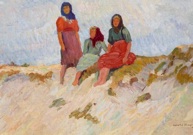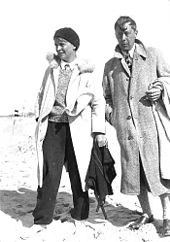Harold Bengen
Harold Tronson Bengen (born January 6, 1879 in Hanover , † March 21, 1962 in Hamburg ) was a German painter whose early works can be assigned to the field of Classical Modernism .
Life
Harold Bengen was the son of a pharmacist specializing in veterinary medicine and grew up in Hanover. His mother (née Tronson) came to Hanover from England as an educator and married the father of Harold Bengen after his first wife had died. The couple had four children. Until 1914, Harold Bengen called himself Harold T. Bengen and signed his work that way, with the T standing for his mother's maiden name. The mother lived in the house of her son Harold and his family until her death.
Harold Bengen attended the humanistic grammar school in Hanover and had drawing lessons from Ernst Jordan as a pupil . From 1896 Bengen studied at the art school in Weimar with Frithjof Smith-Hald . From 1898 to 1899 he continued his studies in Graz. He then lived as a freelance artist in Hanover. From 1905 he stayed frequently on Hiddensee together with his future wife Emmy. Much of his work dates from this time.
In 1908 he became a teacher of drawing and decorative painting at the Berlin-Charlottenburg School of Applied Arts . In 1910 Bengen founded the artist group Neue Sezession in Berlin together with Georg Tappert and Max Pechstein . In 1920 Bengen took part in the winter exhibition of the " Berlin Secession ". In the same year he received the title of professor at the Berlin-Charlottenburg School of Applied Arts. His students included u. a. Hannah Höch and Nikolaus Sagrekow. In the early 1920s, Bengen designed the costumes for Max Reinhardt's production of “The Merchant of Venice” at the Deutsches Theater Berlin . He also devoted himself to the design of mosaics and glass windows. In 1928 Bengen took a trip to South America, which was reflected in a series of watercolors and pastel drawings.
In the 1930s, he devoted himself to portrait and commission painting in addition to his teaching position. A portrait of a woman by him was on display in the National Socialist Great German Art Exhibition in Munich. These and similar works, as well as the ceiling painting in the Reichsbank in Berlin and drafts for the Tannenberg monument stand in stark contrast to his early artistic approach. During the war, Bengen moved from Berlin to Holzhausen am Ammersee in 1944 . In 1952 he moved to Hamburg, where two of his three daughters lived. He died there in 1962. The name was forgotten and had a flaw due to the artist's adaptation to the Nazi dictatorship.
plant
Bengen's early works still contain elements of Art Nouveau . The artistic engagement was often about the representation of women. The most expressive and idiosyncratic - mostly strongly colored - works date from the time up to the First World War. Much of the rest of the work was lost during the Second World War . The early works and also those from the 1920s have largely been preserved - they remained untouched and hidden in the cellar until after the death of his wife and were only brought back to daylight by the three daughters. In the course of some exhibitions about the artist colony Hiddensee (in Dachau , Stralsund and Fischerhude ) works by Bengen were presented to the public again.
A catalog of works was drawn up by a granddaughter of Bengen.
literature
- Ruth Negendanck : Hiddensee, The special island for artists. Edition Fischerhuder Kunstbuch, 2005, ISBN 978-3-88132-288-1 . P. 34 ff.
Web links
| personal data | |
|---|---|
| SURNAME | Bengen, Harold |
| ALTERNATIVE NAMES | Bengen, Harold Tronson (full name) |
| BRIEF DESCRIPTION | German painter |
| DATE OF BIRTH | January 6, 1879 |
| PLACE OF BIRTH | Hanover |
| DATE OF DEATH | March 21, 1962 |
| Place of death | Hamburg |




